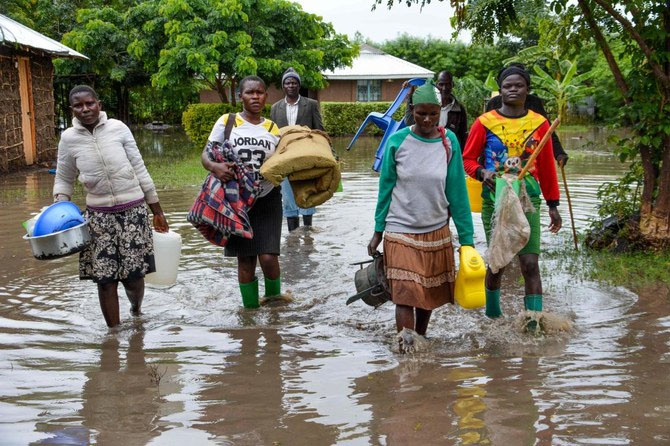
Photo Credit: AFP
Kenyan residents in various parts of the country are suffering heavy losses due to ongoing floods destroying their properties. The Kenyan government sounded an alarm last week after water from Masinga Dam spilled out, which is the largest water reservoir for power production in the country. The dam has surpassed its capacity of 1056.5 cubic meters.
In North Rift region, more than 400 families have been displaced, and several hectares of food crops have been damaged or submerged as floods continue to wreak havoc following recent heavy rains. The floods have also damaged roads and infrastructure, causing disruptions in transport services in several areas. Flash floods have destroyed properties as dams and rivers burst their banks. The Kenya Meteorological Department has warned Kenyans to prepare for more heavy rain.
The Kenya Red Cross Society and county governments in the region are supplying families displaced by floods with medical equipment and drugs to prevent an outbreak of waterborne disease. Moreover, Lake Turkana has burst its banks, and the lake has swollen to unprecedented levels, putting the lives of scores of villagers who rely on it for fish at great risk. Flash floods have hit Lodwar town in the last 24 hours.
Some dams and rivers in the region are likely to burst due to the heavy downpour, and 360 families have been displaced by floods in Lodwar, Turkana County, and are in need of food and non-food items. People residing near the shores of Lake Turkana are spending nights in the cold after the lake water rose and submerged villages and fishing gear. Mr Okumu, the North Rift Kenya Red Cross Manager, said, "Most families affected by floods need psychological and social support, shelter, food and non-food items."
In Nairobi County, the government has directed respective administrators in the sprawling Mukuru slums to remove structures built on riparian land along Ngong River. Residents of the slums have had their houses marooned by floods. A National Environment Management Authority (Nema) official, who requested not to be named, said that structures have been mushrooming on the opposite riparian land, and there is a danger of encroachment near the bridge in Embakasi.
On Sunday, the weatherman predicted that the rains are not yet over and will continue pouring up to June. Roads have turned into rivers in the Kenyan capital Nairobi, as flooding has escalated to extreme levels. Heavy rain has pounded Kenya in recent days, causing widespread devastation. The UN reports that at least 32 people have lost their lives, and more than 40,000 have been forced from their homes due to the rain and flooding.
A five-year-old boy who was left stranded by the flooding was rescued by a police helicopter in Yatta, south of Nairobi, on Tuesday. "The child, visibly shaken by the ordeal after being stranded for quite a long period, was safely rescued and taken to a nearby hospital for care," the Kenya Red Cross said.
Wider East Africa has also been hit hard by heavy rain in recent weeks. Nearly 100,000 people have been displaced in Burundi, while at least 58 people have died in Tanzania. One of the biggest drivers of heavy rain in East Africa is the Indian Ocean Dipole (IOD). The IOD refers to the difference in sea-surface temperatures in opposite parts of the Indian Ocean. During a positive phase, the waters in the western Indian Ocean are much warmer than normal, which can bring heavier rain regardless of El Niño. However, when both a positive IOD and an El Niño occur at the same time, as was the case last year, then the rains in East Africa can become extreme. One of the strongest positive IOD patterns on record coincided with one of the strongest El Niño patterns in 1997 and 1998, with severe flooding reported. These caused more than 6,000 deaths in five countries in the region.






















